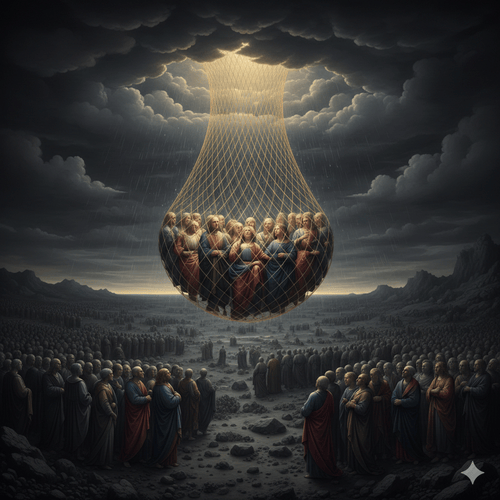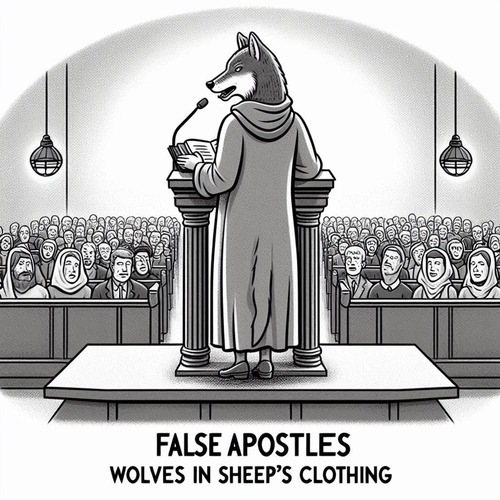Ancient Heresies, New Disguises: Identify the Modern Variants
Throughout church history, the body of Christ has contended with various heresies that threaten the purity of the gospel. As Solomon wisely observed, “There is nothing new under the sun” (Ecclesiastes 1:9). The theological errors that challenge the church today are often simply repackaged versions of ancient heresies the church has already confronted and refuted.
In this post, we’ll examine four significant ancient heresies—Pelagianism, Arianism, Gnosticism, and Nestorianism—and trace their modern manifestations in today’s theological landscape. We’ll explore how each heresy contradicts Scripture and consider a robust defence against these persistent errors.
ANCIENT HERESIES NEW DISGUISES: PELAGIANISM
The Original Error: Pelagianism, named after the British monk Pelagius (354-418 AD), represents one of the most persistent heresies in church history. At its core, Pelagianism denies the doctrine of original sin and human depravity. Pelagius taught:
- Adam’s sin affected only himself, not all humanity
- We’re born morally neutral, not with a sinful nature
- People retain the complete ability to choose good and obey God without divine grace
- Salvation is achieved through moral effort and obedience to God’s commands
Augustine of Hippo vigorously opposed this teaching, and the Council of Carthage condemned Pelagianism in 418 AD. Yet its basic premises—human moral capability and the power of the will—continue to resurface in various forms.
Biblical Refutation: Scripture clearly contradicts Pelagian optimism about human nature:
- Romans 5:12-21: This passage establishes Adam’s sin affected all humanity, not just himself.
- Ephesians 2:1-3: This describes our natural state as spiritually dead—not merely weakened or ill—and therefore, incapable of choosing life.
- Romans 3:10-12: This comprehensive indictment leaves no room for Pelagian optimism about human moral capacity.
- John 6:44: Our very ability to turn to Christ depends on God’s prior work.
The Modern Variants: Pelagianism rarely appears today in its original, explicit form. However, its influence is widespread in diluted or disguised forms:
- Semi-Pelagianism and Arminianism: While not identical to full Pelagianism, these theological systems tend to elevate human free will in salvation. They suggest that fallen humans retain the ability to take the first step toward God or cooperate with grace in a way that ultimately determines their salvation.
- Self-help Gospel: Many popular Christian books and teachers present a message focused on human potential and effort rather than divine grace. When the cross becomes merely a means to personal fulfillment rather than the necessary atonement for sin, Pelagian thinking is at work.
- Prosperity Theology: This movement often implies that blessings come through human faith-actions rather than God’s sovereign grace, subtly promoting works-righteousness.
- Progressive Christianity: By downplaying the reality of sin and divine judgment, many progressive Christian voices echo Pelagius in their optimistic assessment of human nature and capacity.
- Secular Humanism: Though not claiming Christian identity, secular humanism’s confidence in human progress and moral evolution without divine intervention represents Pelagianism in its most secularized form.
The Reformed response emphasises total depravity—not that we’re as evil as we could be, but that sin has affected every aspect of human nature, leaving us unable to save ourselves or even contribute to our salvation. As the Westminster Confession states: “Man, by his fall into a state of sin, hath wholly lost all ability of will to any spiritual good accompanying salvation.”
ANCIENT HERESIES NEW DISGUISES: ARIANISM
The Original Error: Named after Arius, a priest in Alexandria (256-336 AD), Arianism denies the full deity of Jesus Christ. Arius famously claimed: “There was a time when the Son was not.” According to Arian teaching:
- Christ was the first and greatest created being, and was still a creature
- The Son is not eternal or of the same substance as the Father
- Jesus is divine in a secondary, derivative sense—godlike but not fully God
The Council of Nicaea (325 AD) rejected these claims, affirming Christ is “true God from true God, begotten not made, of one substance with the Father.”
Biblical Refutation: Scripture consistently affirms Christ’s full deity:
- John 1:1-3: Christ is explicitly called God and is the agent of all creation, not part of it.
- Colossians 1:15-20: While calling Jesus “the firstborn of all creation,” this passage clarifies that “in him all the fullness of God was pleased to dwell” and that “by him all things were created.” His “firstborn” status refers to pre-eminence, not creation.
- Hebrews 1:1-3: Christ is described as “the radiance of the glory of God and the exact imprint of his nature, and he upholds the universe by the word of his power.” This language of “exact imprint” denotes perfect identity of nature.
- Philippians 2:5-6: Christ “did not count equality with God a thing to be grasped,” indicating that this equality was already His by nature.
Modern Variants: Arianism persists in several contemporary forms:
- Jehovah’s Witnesses Theology: Perhaps the most direct modern descendant of Arianism, this group explicitly teaches that Jesus is a created being—the archangel Michael—rather than the eternal God.
- Mormon Christology: The Church of Jesus Christ of Latter-day Saints teaches that Jesus is the spiritual offspring of heavenly parents, essentially a created being who attained godhood.
- Unitarian Perspectives: Various Unitarian groups continue to deny the Trinity and the full deity of Christ.
- Liberal Theological Approaches: Many liberal scholars present Jesus as merely an exemplary human teacher whose followers later deified him. This “mythological Jesus” approach effectively revives Arianism in academic garb.
- Jesus as “Spiritual Guide”: Popular spirituality often reduces Jesus to one spiritual leader among many, implicitly denying His unique divine status.
The Reformed tradition has always insisted on the full deity of Christ as essential to the gospel. Christ must be fully God for His sacrifice to have infinite value and for Him to be a proper object of worship.
ANCIENT HERESIES NEW DISGUISES: GNOSTICISM
The Original Error: Gnosticism wasn’t a single movement but a diverse collection of religious ideas that flourished in the first few centuries AD. Despite their diversity, Gnostic systems generally taught:
- Salvation comes through secret knowledge (gnosis) rather than faith or grace
- A radical dualism between the spiritual realm (good) and the material world (evil)
- The physical body is a prison for the divine spark within humanity
- The God of the Old Testament is an inferior, even malevolent deity distinct from the true God
- Jesus only appeared to be physical (docetism) since the divine could not truly unite with corrupt humanity
Early church fathers Irenaeus and Tertullian vigorously opposed these teachings as fundamentally incompatible with apostolic Christianity.
Biblical Refutation: Scripture consistently contradicts Gnostic premises:
- Colossians 2:8-10: Paul warns against “philosophy and empty deceit” while affirming that “in [Christ] the whole fullness of deity dwells bodily”—a direct counter to docetic tendencies.
- 1 John 4:1-3: “Every spirit that confesses that Jesus Christ has come in the flesh is from God, and every spirit that does not confess Jesus is not from God.” John directly confronts the docetic aspect of Gnosticism.
- 1 Timothy 4:1-5: Paul opposes those who “forbid marriage and require abstinence from foods that God created,” affirming instead that “everything created by God is good.” This counters Gnostic denigration of the material world.
- Genesis 1: The repeated affirmation that God’s physical creation is “good” contradicts the Gnostic view of matter as inherently evil.
Modern Variants: Gnosticism’s influence persists in several contemporary forms:
- New Age Spirituality: With its emphasis on intuitive spiritual knowledge and the divine within, New Age thought echoes many Gnostic themes.
- Progressive Christianity’s Mysticism: Some progressive Christian voices prioritize subjective spiritual experience over biblical authority, reflecting Gnosticism’s elevation of inner knowledge.
- Prosperity Gospel’s Esoteric Claims: Some prosperity teachers claim special revelation or interpretive keys that unlock biblical “secrets” to health and wealth—a modern form of saving gnosis.
- Mind-Body Dualism: Contemporary spirituality often devalues the physical in favor of the spiritual, reflecting Gnostic dualism.
- Christian Science and Similar Movements: These groups’ denial of the reality of matter and physical evil represents Gnosticism’s most direct modern expression.
The Reformed tradition has consistently affirmed the goodness of creation, the authority of Scripture over private revelation, and the reality of Christ’s physical incarnation against all Gnostic tendencies.
ANCIENT HERESIES NEW DISGUISES: NESTORIANISM
The Original Error: Nestorianism, associated with Nestorius, Patriarch of Constantinople (386-450 AD), overemphasised the distinction between Christ’s divine and human natures. While Nestorius himself may not have held all the views attributed to him, Nestorianism came to represent the teaching that:
- Christ’s divine and human natures are so distinct they effectively constitute two separate persons
- Mary should be called “Christotokos” (Christ-bearer) but not “Theotokos” (God-bearer)
- The human Jesus could be considered separately from the divine Logos who indwelled him
The Council of Ephesus (431 AD) condemned these views, affirming the unity of Christ’s person while maintaining the distinction of His natures.
Biblical Refutation: Scripture presents Christ as one integrated person:
- John 1:14: “The Word became flesh and dwelt among us.” The eternal Word didn’t merely join with flesh; He became flesh while remaining the Word.
- Philippians 2:5-11: This passage traces a single subject through pre-existence in divine form, incarnation, humiliation, death, and exaltation.
- Hebrews 2:14-18: The author emphasizes that Christ fully shares in our humanity precisely so that He can serve as our high priest and make propitiation for sins—functions requiring both full humanity and deity.
- Colossians 2:9: “In him the whole fullness of deity dwells bodily.” The text doesn’t present deity as merely adjoined to Christ’s humanity, but as dwelling fully within His bodily existence.
Modern Variants: Nestorianism’s influence continues in several forms:
- The “Jesus of History” vs. “Christ of Faith” Dichotomy: Many liberal theological approaches create an artificial division between the historical human Jesus and the divine Christ proclaimed by the church.
- Functional Kenoticism: Some contemporary theologians suggest that Christ temporarily surrendered divine attributes during His earthly ministry, effectively dividing His natures.
- Over-emphasis on Christ’s Humanity: Some progressive Christian voices focus almost exclusively on Jesus as human exemplar, tacitly treating His deity as secondary or metaphorical.
- Some Charismatic Teachings: Certain strands of charismatic theology functionally separate Christ’s work and person in ways that reflect Nestorian tendencies.
The Reformed tradition has consistently maintained that Christ is one person with two natures—fully God and fully man. The Westminster Confession affirms that these two natures are “without conversion, composition, or confusion.”
CONCLUSION: ANCIENT HERESIES NEW DISGUISES
The battle against heresy isn’t merely academic—false teaching has real consequences for the spiritual health of believers and the witness of the church. Scripture warns us “the time is coming when people will not endure sound teaching, but having itching ears they will accumulate for themselves teachers to suit their own passions” (2 Timothy 4:3).
By recognising these ancient patterns of error in their contemporary disguises, we stand in the long tradition of those who’ve contended for the faith once delivered to the saints (Jude 3). The heresies may be old, but their refutation rests on the eternal truth of God’s Word, which stands forever (Isaiah 40:8).
“Guard the deposit entrusted to you. Avoid the irreverent babble and contradictions of what is falsely called ‘knowledge,’ for by professing it some have swerved from the faith.” — 1 Timothy 6:20-21
ANCIENT HERESIES NEW DISGUISES: RELATED FAQs
Can a genuine Christian unknowingly hold heretical views? Yes, regenerate believers can and do sometimes hold inconsistent or even heretical views while still being truly saved. The Reformed tradition distinguishes between errors that are fundamentally incompatible with saving faith (such as denying Christ’s deity) and those that, while serious, may coexist with genuine faith due to immaturity or poor teaching. What matters ultimately is not perfect theological precision but whether one is trusting in the true Christ of Scripture for salvation.
- How should Reformed churches approach ecumenical dialogue with denominations that may hold some heretical views? Reformed churches should approach ecumenical dialogue with both conviction and charity, never compromising on essential doctrines while recognising not all theological differences are of equal weight. We can cooperate on matters of common concern (such as religious liberty or social justice) while still maintaining clear theological boundaries on salvation-related doctrines. The goal should always be truth in love, neither sacrificing doctrinal fidelity for false unity nor using doctrinal precision as an excuse for lovelessness.
- Why do these ancient heresies keep reappearing throughout church history? Heresies persist because they appeal to natural human tendencies—Pelagianism flatters our self-sufficiency, Arianism makes Christ more ‘comprehensible’ to human reason, Gnosticism appeals to our desire for special insider knowledge, and Nestorianism simplifies the mystery of the incarnation. These errors represent the default patterns of fallen human reasoning when approaching divine truth without full submission to Scripture. Additionally, since most modern Christians are unfamiliar with historical theology, they often don’t recognise these patterns when they encounter them in contemporary teaching.
How does covenant theology help us respond to these heresies? Covenant theology provides a comprehensive framework that counters multiple heresies simultaneously by emphasising God’s sovereign initiative in salvation history. It refutes Pelagianism by highlighting the covenant of grace as God’s unilateral promise rather than a bilateral contract dependent on human merit. It counters Gnosticism by affirming the goodness and importance of the physical creation within God’s covenant purposes. It addresses both Arianism and Nestorianism by showing how the covenant mediator must be both fully divine and fully human in one person to represent both parties.
- Is it appropriate to label contemporary teachers as “heretics” if they teach these errors? We should be extremely cautious about employing the label “heretic,” especially toward individuals rather than teachings. Reformed Christians should distinguish between those who knowingly reject established orthodox doctrine (formal heresy) and those who may hold erroneous views due to ignorance or confusion. While we must clearly identify false teaching, we should focus our critique on the ideas rather than pronouncing judgment on persons, remembering that final judgment belongs to God alone.
ANCIENT HERESIES NEW DISGUISES: OUR RELATED POSTS
Editor's Pick

Why Do People Hate the Doctrine of Election?
…WHEN THEY REALLY SHOULDN’T Few Bible doctrines provoke stronger reactions than election. The idea that God chose some for salvation [...]

The Doctrine of Providence: Does God Really Govern All Things?
You’re sitting in the doctor’s office when the diagnosis lands like a thunderclap. Your mind races: Why this? Why now? [...]

No Decay, No Defeat: What It Means That Christ’s Body Saw No Corruption
On the Day of Pentecost, Peter stood before thousands and made a startling claim: David's body decayed in the tomb, [...]
SUPPORT US:
Feel the Holy Spirit's gentle nudge to partner with us?
Donate Online:
Account Name: TRUTHS TO DIE FOR FOUNDATION
Account Number: 10243565459
Bank IFSC: IDFB0043391
Bank Name: IDFC FIRST BANK






